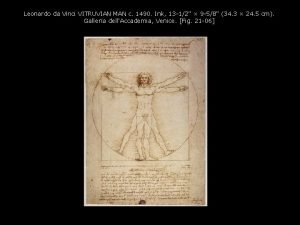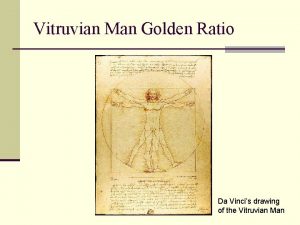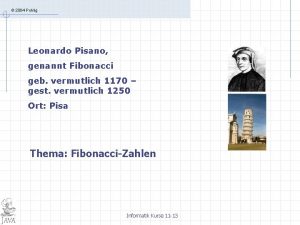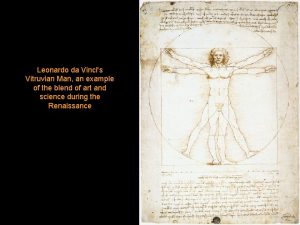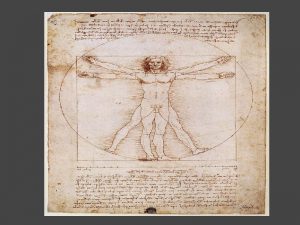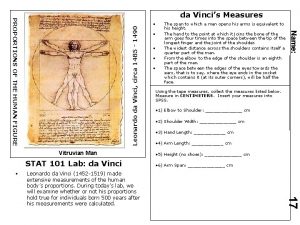Leonardo Da Vincis Vitruvian Man The Vitruvian Man












- Slides: 12

Leonardo Da Vinci’s Vitruvian Man

The 'Vitruvian Man' is a famous drawing with accompanying notes by Leonardo da Vinci made around the year 1492 in one of his journals. It depicts a naked male figure in two superimposed positions with his arms and legs apart and simultaneously inscribed in a circle and square. The drawing and text are sometimes called the Canon of Proportions or, less often, Proportions of Man. It is on display in the Gallerie dell' Accademia in Venice, Italy.

According to Leonardo's notes in the accompanying text (written in mirror writing) it was made as a study of the proportions of the (male) human body as described by the Ancient Roman architect Vitruvius, who wrote that in the human body: “…the length of a man's outspread arms is equal to his height …” Arm Span Height

The Vitruvian theory contains a total of 10 ratios between different parts of the body. Can you verify four of these ratios using data collected from your class? Here is a reminder of the first: Height is equal to arm span Arm Span Height

2. Length from the elbow to the end of the hand is equal to one quarter of height Elbow to end of hand Height

3. Length of the hand is one tenth of height Hand Height 4. Length of the foot is one seventh of height Foot

Is the Vitruvian theory that height is equal to arm span true for British students today? Complete the following tables by making the appropriate measurements of yourself and your classmates.

Height is equal to arm span Pupil Gender M or F Height Arm Span centimetres Ratio Height / Arm Span Fraction * Decimal 1 2 3 4 5 6 7 8 9 10 Click in a cell to enter data * Leave fraction un-simplified

Elbow to hand is equals one quarter of height Pupil Gender M or F Height Elbow to Hand centimetres Ratio Height / Elbow to Hand Fraction * Decimal 1 2 3 4 5 6 7 8 9 10 Click in a cell to enter data * Leave fraction un-simplified

Length of the hand is one tenth of height Pupil Gender M or F Height Hand Length centimetres Ratio Height / Hand Fraction * Decimal 1 2 3 4 5 6 7 8 9 10 Click in a cell to enter data * Leave fraction un-simplified

Length of the foot is one seventh of height Pupil Gender M or F Height Foot Length centimetres Ratio Height / Foot Fraction * Decimal 1 2 3 4 5 6 7 8 9 10 Click in a cell to enter data * Leave fraction un-simplified

Some questions to think about… What do you notice from the table of data? Which pupils most closely fit Leonardo’s theory? Not everybody has an arm span / height ratio equal to 1. Why do you think this is? Do you think the results would be the same for babies or seniors? Who might be interested in your conclusions?
 Man vs society def
Man vs society def Vitruvian man theory
Vitruvian man theory Michelangelo pieta rom
Michelangelo pieta rom Vitruvian man golden ratio
Vitruvian man golden ratio Vitruvian man ratio
Vitruvian man ratio Leonardo fibonacci leonardo pisano (fibonacci)
Leonardo fibonacci leonardo pisano (fibonacci) Avarice and prodigality
Avarice and prodigality True renaissance man
True renaissance man Leonardo di vinci man
Leonardo di vinci man Tư thế ngồi viết
Tư thế ngồi viết Hình ảnh bộ gõ cơ thể búng tay
Hình ảnh bộ gõ cơ thể búng tay đặc điểm cơ thể của người tối cổ
đặc điểm cơ thể của người tối cổ Cái miệng nó xinh thế
Cái miệng nó xinh thế


